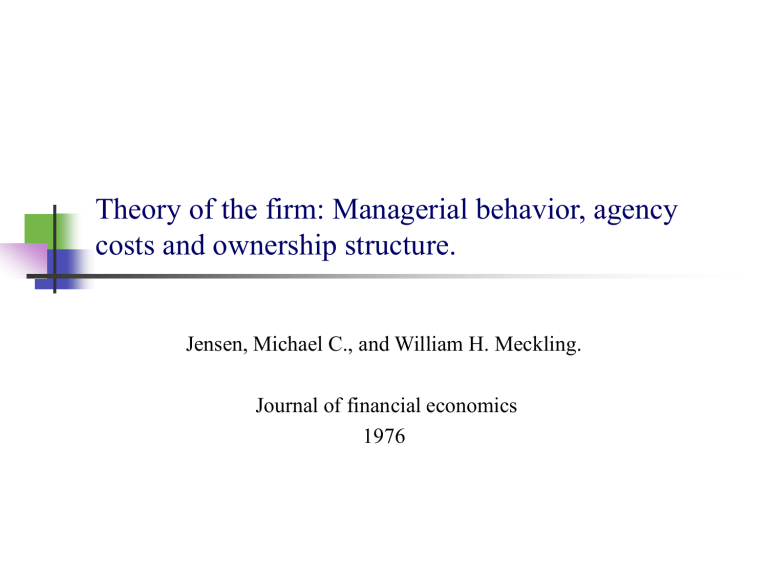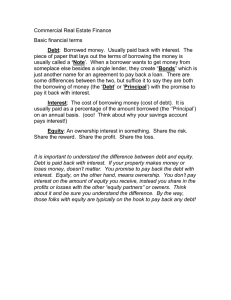
Theory of the firm: Managerial behavior, agency costs and ownership structure. Jensen, Michael C., and William H. Meckling. Journal of financial economics 1976 Background 1. 2. 3. 1. 2. 3. Agency Costs the monitoring expenditures by the principal the bonding expenditures by the agent the residual loss Normative aspects Positive aspects of the theory Manager Outside equity holders Debt holders Definition of the firm: No individual, but legal fiction Structure Introduction The Agency Costs of Outside Equity Some unanswered questions regarding the existence of the corporate form The Agency Costs of Debt A Theory of the Corporate Ownership Structure Qualifications and Extensions of the Analysis Conclusions The Agency Costs of Outside Equity 1. 2. 3. Analysis of the Sources of Agency Costs of Equity and Who Bears Them Theorem. For a claim on the firm of (1-a) the outsider will pay only (1-a) times the value he expects the firm to have given the induced change in the behavior of the owner-manager. The decline in the total value of the firm (V*-V’) is entirely imposed on the owner-manager. Managers would sell such a claim only if the increment in welfare he achieved by using the cash amounting to (1-α)V’ for other things was worth more to him than this amount of wealth. The Agency Costs of Outside Equity Determination of the Optimal Scale of the Firm (ΔV-ΔI)–(1-α)ΔF=0 The manager stops increasing the size of the firm when the gross increment in value is just offset by the incremental “loss” involved in the consumption of additional fringe benefits due to his declining fractional interest in the firm. The Agency Costs of Outside Equity 1. 2. 3. The Role of Monitoring and Bonding Activities in Reducing Agency Costs An analysis of monitoring expenditures. An analysis of bonding expenditures. Optimal scale of the firm in the presence of monitoring and bonding activities. Pareto Optimality and Agency Costs in Manager-Operated Firms 1. 2. 3. Agency costs are non-zero (i.e., that there are costs associated with the separation of ownership and control in the corporation) and the agency relationship is nonoptimal, wasteful or inefficient. Factors Affecting the Size of the Divergence from Ideal Maximization Tastes of managers the Cost of measuring the manager’s performance Capital markets Monopoly, competition and managerial behavior. Some unanswered questions regarding the existence of the corporate form Why, given the existence of positive costs of the agency relationship, do we find the usual corporate form of organization with widely diffuse ownership so widely prevalent? Why, if non-manager-owned shares have such a serious deficiency, have they not long since been driven out by fixed claims? The role of limited liability. The “irrelevance” of capital structure. The Agency Costs of Debt The Incentive Effects Associated with Debt Owner-manager will have a strong incentive to engage in activities (investments) which promise very high payoffs if successful even if they have a very low probability of success. If they turn out well, he captures most of the gains, if they turn out badly, the creditors bear most of the costs. The Agency Costs of Debt The Role of Monitoring and Bonding Costs The costs involved in writing such provisions, the costs of enforcing them and the reduced profitability of the firm (induced because the covenants occasionally limit management’s ability to take optimal actions on certain issues) Bankruptcy and Reorganization Costs The price buyers will be willing to pay for fixed claims will thus be inversely related to the probability of the incurrence of these costs i.e., to the probability of bankruptcy. The Agency Costs of Debt 1. 2. Why Are the Agency Costs of Debt Incurred? Tax subsidy on interest payments An opportunity loss A Theory of the Corporate Ownership Structure Determination of the Optimal Ratio of Outside Equity to Debt A Theory of the Corporate Ownership Structure 1. 2. 3. Effects of the Scale of Outside Financing As the amount of outside equity increases, the owner’s fractional claim on the firm, α, falls. He will be induced thereby to take additional non-pecuniary benefits out of the firm because his share of the cost falls. This also increases the marginal benefits from monitoring activities and therefore will tend to increase the optimal level of monitoring. The agency cost of debt will similarly rise as the amount of outside financing increases. because the total amount of resources which can be reallocated from bondholders increases as the total amount of debt increases. We hypothesize that the larger the firm becomes the larger are the total agency costs because it is likely that the monitoring function is inherently more difficult and expensive in a larger organization. A Theory of the Corporate Ownership Structure 1. 2. Risk and the Demand for Outside Financing If the returns from assets are not perfectly correlated an individual can reduce the riskiness of the returns on his portfolio by dividing his wealth among many different assets, i.e., by diversifying. The costs to avoid this risk he must bear to accomplish this diversification will be the agency costs above. Determination of the Optimal Amount of Outside Financing, K* Qualifications and Extensions of the Analysis Multiperiod aspects of the agency problem The Control Problem and Outside Owner’s Agency Costs A Note on the Existence of Inside Debt and Some Conjectures on the Use of Convertible Financial Instruments Monitoring and the Social Product of Security Analysts Specialization in the Use of Debt and Equity Application of the Analysis to the Large Diffuse Ownership Corporation The Supply Side of the Incomplete Markets Question



